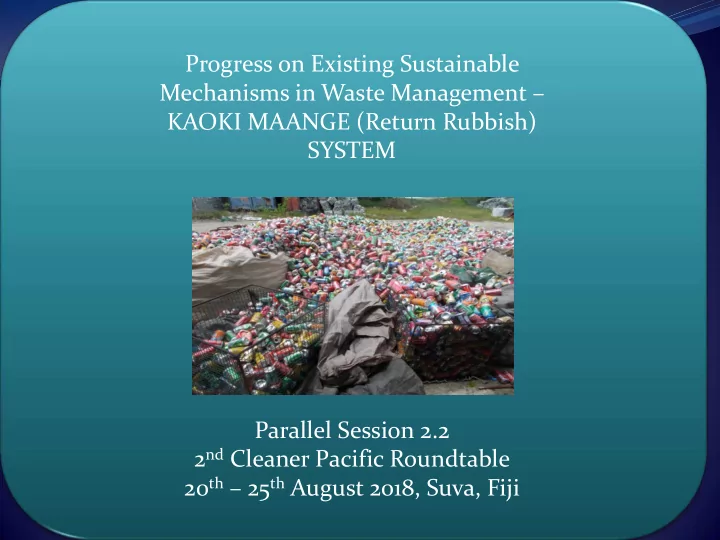

Progress on Existing Sustainable Mechanisms in Waste Management – KAOKI MAANGE (Return Rubbish) SYSTEM Parallel Session 2.2 2 nd Cleaner Pacific Roundtable 20 th – 25 th August 2018, Suva, Fiji
Outline of Presentation • Background of KM (Return wastes) System • Legislated container deposit – Special Fund (Waste material recovery) Act • How the deposit system works • Success • Challenges
Background of Kaoki Maange System • Started as a pilot project in 2003 • Financially supported by UNDP, executed by the Ministry of Commerce and Industry Cooperatives (MCIC) and implemented by the Foundation of the South People in Kiribati (FSP-K). • Project was tendered out for public interest in 2004. The private operator took over in 2005. • Legislating the Container Deposit in 2005. Special Fund (Waste Material Recovery) Act assented in February 2005 and its regulation was endorsed in May, same year.
Special Fund (Waste Material Recovery) Act • Part I – Preliminary • Par II – Deposit • Power of the Minister to levy deposits for waste material recovery • Who and how to pay the levy deposit • Part III – Establishment of the Special Fund and how payment is made into the Fund • Part IV – Supplementary provisions • Offences
How the deposit system works • 5 cents is paid at import for every legislated item (PET plastic bottle (No.1) bottle and aluminum drink cans). • Money is collected by the Kiribati Customs Service at first entry and deposited into the Special Fund. • 4 cents is paid to any members of the public who brings the recyclable items to the waste collection point. • 1 cent is paid to the waste recovery operator to meet the operational costs for recovering and recycling waste materials. • $5 dollars for lead-acid batteries (car batteries)
Success stories Establishment of container deposit legislation – Special Fund (Waste material recovery) Act. Since the establishment of the Kaoki Maange (Waste Recovery) system until 2018, the volume of waste items that have been exported for recycling is 564 tonnes. The figure represents the following; o 268 tonnes for aluminum cans o 92 tonnes for PET bottles o 204 tonnes for scrap batteries (car batteries) Provides employment Scrap vehicle recycling system is now under preparation following the model of the aluminum cans and PET bottles. The Cabinet paper has been endorsed for this system.
Challenges • Space for stockpiling the recyclable items is getting insufficient. Failure of equipment (truck) to transport the recyclable items from individual collection points to the main. PET bottles need to be well cleaned before shipment. This was not the case for Kiribati and therefore awareness to the public is needed.
KAM RABWA!!!
Recommend
More recommend